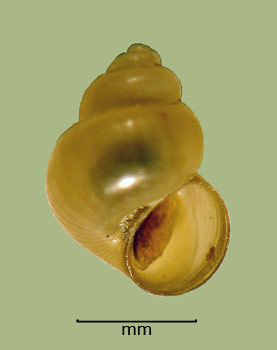Cincinnatia Sp. 1
> Habitat & Distribution
This species is known only from Lake Waccamaw, Columbus County, North Carolina, and its tributary Big Creek (SCFTM 1990). Porter (1985) reported an average density of 273 per square meter in the lake, reaching maximum abundance in shallow, sandy regions with emergent vegetation. Population densities seem much reduced more recently, however. (See my blog post of 16July10 from the link below for more.) FWGNA incidence rank I-2, rare.
> Ecology & Life History
Hydrobiids seem to be rather nonspecific grazers of small particles (Dillon 2000: 94-97). The laboratory feeding experiments of Schultheis & Kellmann (2013) showed that a mixed diet of the yellow-green filamentous Vaucheria and the blue-green filamentous Lyngbya was superior to either alga in pure diet for Floridobia floridana.
Hydrobioids are (almost) universally dioecious, the males being characterized by a penis that arises from the neck. Females attach single eggs in spare, hemispherical capsules to solid substrates (Hershler 1994).
> Taxonomy & Systematics
Like Spilochlamys,
Notogillia,
and Marstonia,
the genus Floridobia
belongs to the subfamily Nymphophilinae of the Hydrobiidae
(ss), males being
characterized by a lobe-shaped penis (or verge) with surficial
glandular patterns. The Floridobia
penis has crescent-shaped terminal and ventral glands on its large
terminal penial lobe and a slender flagellum (Kabat and Hershler 1993,
Thompson 1968, 2004).
The genus Floridobia
has only recently been distinguished from Cincinnatia,
on the basis of female reproductive anatomy (Thompson &
Hershler
2002). There are three (nominal) species in our study area - Floridobia floridana
(ranging through Florida into southern Georgia) and two
apparently
undescribed species, one in the Ocmulgee
River and this second
inhabiting Lake Waccamaw.
Interestingly, the mtDNA survey of Hershler et al. (2003) revealed little differentiation between Floridobia and the (primarily western) hydrobiid genus Pyrgulopsis. The difference between Floridobia and Marstonia seems to be more pronounced.
> Maps and Supplementary Resources
> Essays
- The Waccamaw population of Floridobia was mentioned prominently in my blog post of 16July10, "Crisis at Lake Waccamaw."
- Conservation-biased oversampling of the Waccamaw Floridobia population was featured in my blog post of 19Mar12, "Toward the Scientific Ranking of Conservation Status - Part III."
- Earlier versions of this website, online until August of 2016, adopted the large, broadly-inclusive concept of the Hydrobiidae (sl) following Kabat & Hershler (1993). More recently the FWGNA project has shifted to the Wilke et al. (2013) classification system, distinguishing a much smaller Hydrobiidae (ss) and elevating many hydrobioid taxa previously ranked as subfamilies to the full family level. For more details, see The Classification of the Hydrobioids.
> References
Dillon, R.T., Jr. (2000)
The Ecology of Freshwater Molluscs. Cambridge University Press,
Cambridge, United Kingdom.
Hershler, R. (1994)
A review of the North American freshwater snail genus Pyrgulopsis
(Hydrobiidae). Smithsonian Contributions to Zoology 1994; 0(554):1-115.
Hershler, R., H. Liu, and
F.G. Thompson (2003)
Phylogenetic relationships of North American nymphophiline gastropods
based on mitochondrial DNA sequences. Zoologica Scripta
32:357-366.
Kabat, A.R., and R.
Hershler (1993)
The prosobranch snail family Hydrobiidae (Gastropoda: Rissooidea):
review of classification and supraspecific taxa. Smithsonian
Contributions to Zoology 547:1-94.
Porter, H. J. (1985)
Molluscan
census and ecological interrelationships. Rare and endangered fauna of
Lake Waccamaw, North Carolina watershed system. NC Endangered Species
Restoration Final Report, 1978-1981. NCWRC report.
Schultheis, A. S.
& C. R. Kellmann (2013)
Cyanobacteria-rich diet reduces growth rates of the hyacinth
siltsnail Floridobia
floridana (Gastropoda: Hydrobiidae) Walkerana
16: 1 - 8.
Scientific Council on
Freshwater and Terrestrial Mollusks. (1990)
(W. F. Adams, Chair) A report on the conservation status of North
Carolina's freshwater and terrestrial molluscan fauna.
Thompson, F.G. (1968)
The
Aquatic Snails of the Family Hydrobiidae of Peninsular Florida.
University of Florida Press, Gainesville, Florida,
USA.
Thompson,
F.G. (2004) An identification manual
for the freshwater snails of Florida.
Thompson, F. G. & R. Hershler (2002) Two
genera of North American freshwater snails: Marstonia Baker,
1926, resurrected to generic status, and Floridobia, new
genus (Prosobranchia: Hydrobiidae: Nymphophilinae). The
Veliger 45: 269 - 271.
Wilke T., Haase M., Hershler R.,
Liu H-P., Misof
B., Ponder W. (2013)
Pushing short DNA
fragments to the limit: Phylogenetic relationships of hydrobioid
gastropods
(Caenogastropoda: Rissooidea). Molecular
Phylogenetics and Evolution 66: 715 736.








